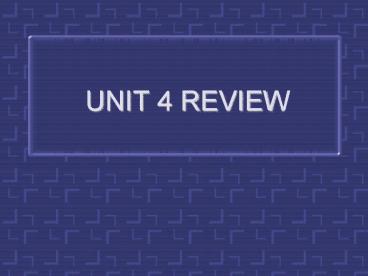UNIT 4 REVIEW - PowerPoint PPT Presentation
Title:
UNIT 4 REVIEW
Description:
UNIT 4 REVIEW Devolution Process of transferring some power from the central government to regional governments. Balkanization Division of a region or state into ... – PowerPoint PPT presentation
Number of Views:236
Avg rating:3.0/5.0
Title: UNIT 4 REVIEW
1
UNIT 4 REVIEW
2
WHAT IS POLITICAL GEOGRAPHY
3
Political Geography
- Study of human political organization of the
earth at various geographic levels.
4
KEY TERMS
5
Territoriality
- Control over a space and the assumption of
ownership to that space.
6
Sovereignty
- Internationally recognized control of a state
over the people and territory within its
boundaries.
7
State
- Political unit with a permanent population,
territorial boundaries recognized by other
states, an effective government, a working
economy, and sovereignty.
8
Nation
- Group of people who share a common culture and
identify as a cohesive group.
9
Stateless Nation
- Nation without territory to call its own
10
Nation-state
- State containing one nation, a cohesive group of
people linked to their territory through a shared
government and common goals.
11
Satellite State
- Country controlled by a more powerful state.
12
Centripetal Force
- Force that unifies a states people and regions.
13
Centrifugal Force
- Force that divides a states people and regions.
14
Federal Government Structure
- Organizational structure with a central
government that shares power with strong regional
governments.
15
Unitary Governmental Structure
- Organizational structure in which one main
governmental decision-making body exists for the
entire state. Regions within the country may have
their own local governments, but they are weak
and usually serve only as administrative organs
of the primary government based in the countrys
capital.
16
Gerrymandering
- Redrawing electoral boundaries to give one
political party an advantage over others.
17
(No Transcript)
18
(No Transcript)
19
BOUNDARIES
20
Physical (or natural) political boundary
- Political boundary that separates territories
according to natural features in the landscape,
such as mountains, deserts, or rivers.
21
Superimposed Boundary
- Boundary forcibly put on a landscape by outsiders.
22
Relict Boundary
- Boundary that no longer functions as a boundary
but only as a reminder of a line that once
divided space.
23
SHAPES OF STATES
- LOOK AT PG. 180 IN YOUR TEST PREP BOOK
24
SOUTH AFRICA-PERFORATED
25
RWANDA-COMPACT
26
THAILAND-PRORUPTED
27
CHILE-ELONGATED
28
INDONESIA-FRAGMENTED
29
Colonialism
- Control by a developed state over an
underdeveloped area.
30
COLONIAL POSSESSIONS IN 1914
31
Imperialism
- The process of establishing political, social,
and economic dominance over a colonized area
32
Supranationalism
- Growing trend of three or more countries forming
an alliance for cultural, economic, and political
situation.
33
EXAMPLES OF SUPRANATIONAL ORGANIZATIONS
- United Nations
- NATO
- Warsaw Pact
- European Union
- NAFTA
34
Devolution
- Process of transferring some power from the
central government to regional governments.
35
Balkanization
- Division of a region or state into smaller units,
usually along ethnic lines.
36
THEORIES
37
Dependency Theory
- According to this theory, former colonies in
South America, Africa, and Asia have not been
able to heal from imperial domination and are
still dependent on their former European
colonizers.
38
(No Transcript)
39
(No Transcript)
40
Mackinders Heartland Theory
- Geopolitical theory that Eurasia was the world
island and the key to dominating the world.
Ruling this world island required controlling
eastern Europe linked to the domino theory.
41
Rimland Theory
- Nicolas Spykmans theory defining the rimland to
be all of Eurasias periphery, not its core of
Russia and Central Asia. This rimland was the key
to controlling the world island.
42
(No Transcript)































